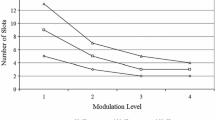Abstract
Optical dense wavelength division multiplexed (DWDM) networks are an attractive candidate for the next generation Internet and beyond. In this paper, we consider routing and wavelength assignment in a wide area wavelength routed backbone network that employs circuit-switching. When a session request is received by the network, the routing and wavelength assignment (RWA) task is to establish a lightpath between the source and destination. That is, determine a suitable path and assign a set of wavelengths for the links on this path. We consider a link state protocol approach and use Dijkstra’s shortest path algorithm, suitably modified for DWDM networks, for computing the shortest paths. In [1] we proposed WDM aware weight functions that included factors such as available wavelengths per link, total wavelengths per link. In this paper, we present new weight functions that exploit the strong correlation between blocking probability and number of hops involved in connection setup to increase the performance of the network. We also consider alternate path routing that computes the alternate paths based on WDM aware weight functions. The impact of the weight functions on the blocking probability and delay is studied through discrete event simulation. The system parameters varied include number of network nodes, wavelengths, degree of wavelength conversion, and load. The results show that the weight function that incorporates both hop count and available wavelength provides the best performance in terms of blocking probability.
Similar content being viewed by others
References
T. Fabry-Asztalos, N. Bhide, K. M. Sivalingam, Adaptive weight functions for shortest path routing algorithms for multi-wavelength optical wdm networks, in Proc. of ICC 2000, vol. 3, New Orleans, LA, (June 2000), pp. 1330-1334.
K. Sivalingam, S. Subramaniam, ed, Optical WDM Networks: Principles and Practice, (Kluwer Academic Publishers, Boston, MA, 2000).
H. Zang, J. P. Jue, B. Mukherjee, A review of routing and wavelength assignment approaches for wavelength-routed optical WDM networks, Optical Networks Magazine, vol. 1,no. 1, (January 2000), pp. 47-60.
Z. Zhang, A. S. Acampora, A heuristic wavelength assignment algorithm for multihop WDM networks with wavelength routing and wavelength re-use, IEEE/ACM Transactions on Networking, vol. 3,no. 3, (June 1995), pp. 281-288.
B. Mukherjee, Optical Communication Networks, (Addison Wesley, 1997).
E. Karasan, E. Ayanoglu, Effects of wavelength routing and selection algorithms on wavelength conversion gain in WDM networks, IEEE/ACM Transactions on Networking, vol. 6,no. 2, (April 1998), pp. 186-196.
A. Mokhtar, M. Azizõglu, Adaptive wavelength routing in all-optical networks, IEEE/ACM Transactions on Networking, vol. 6,no. 2, (April 1998), pp. 197-206.
R. Ramaswami, K. N. Sivarajan, Design of logical topologies for wavelength-routed optical networks, IEEE Journal on Selected Areas in Communications, vol. 14,no. 5, (June 1996), pp. 840-851.
J. T. Moy, OSPF: Anatomy of an Internet Routing Protocol, (Addison-Wesley, 1998).
J. R. Jump, YACSIM Reference Manual, Rice University, Department of Electrical and Computer Engineering, first edition, (August 1992).
Author information
Authors and Affiliations
Rights and permissions
About this article
Cite this article
Bhide, N.M., Sivalingam, K.M. & Fabry-Asztalos, T. Routing Mechanisms Employing Adaptive Weight Functions for Shortest Path Routing in Optical WDM Networks. Photonic Network Communications 3, 227–236 (2001). https://doi.org/10.1023/A:1011495129926
Issue Date:
DOI: https://doi.org/10.1023/A:1011495129926




